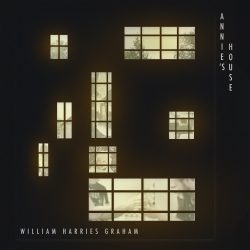A song cycle for every guy who has had a tattoo of his girlfriend’s name inside a heart on his arm. Then she leaves.
 “Annie’s House” is the fourth album from William Harries Graham since his debut ten years ago with the band, The Painted Redstarts. He was born with musical genes as his father is singer/songwriter Jon Dee Graham, but all similarities end at the family name. Jon Dee began as a rock ‘n roller with The Skunks before joining Alejandro Escovedo and his brother Javier in The True Believers, a groundbreaking band whose music was dubbed cowpunk by critics. Even after going solo, his music remained edgy and concerned with adult themes like raising a family, mortgages and the fleeting nature of life. For his son, it’s apparent the apple has not fallen closely to the tree, not that it should. Rufus Wainwright is musically miles removed from dad Loudon, and he’s done okay.
“Annie’s House” is the fourth album from William Harries Graham since his debut ten years ago with the band, The Painted Redstarts. He was born with musical genes as his father is singer/songwriter Jon Dee Graham, but all similarities end at the family name. Jon Dee began as a rock ‘n roller with The Skunks before joining Alejandro Escovedo and his brother Javier in The True Believers, a groundbreaking band whose music was dubbed cowpunk by critics. Even after going solo, his music remained edgy and concerned with adult themes like raising a family, mortgages and the fleeting nature of life. For his son, it’s apparent the apple has not fallen closely to the tree, not that it should. Rufus Wainwright is musically miles removed from dad Loudon, and he’s done okay.
Williams Harries’ songs are steeped in longing, and like a tea bag left too long in a mug, they have a tendency to turn to dark memories of a personal nature, mostly of a relationship that no longer works. The lead single on the album is ‘Ohio State,’ which neatly summarizes what you’ll hear on the other nine tracks. It’s a heavy dose of nostalgia and longing for what once was or could have been if only, well … things had been different. Graham is desperate to know: Do you still see me somewhere in your future? Are you still friends with all your exes? Sure, who hasn’t heard the old let’s stay friends line during a breakup? The source of his pain is named Annie, same as the girl in the album’s opening song ‘Annie, Are You Still There?’ He wishes they had given up on giving up, but Annie gave up on them.
“I had the first verse, but couldn’t find the rest until I overheard a farmer talking about a pact he’d made with his college sweetheart to find each other once again later in life,” Graham said about the first single. “The feeling that you know you can’t be together now, but maybe one day. It feels like a lot of people have had a conversation like that.”
It’s the hope for an ending like in “What Happens Later,” Meg Ryan’s latest rom-com where she and David Duchovny finally get back together after twenty years apart. 99% of the time that never happens. You put two and two together – metaphorically, not in a relationship sense – and realize this album is a song cycle that tells the story of one guy’s disbelief that it’s over. Did you fall asleep aware? Did you wake up at night with a complex list of demands? Did you tell a lie to your lover? Did you fall in love with another? Questions that do no good being answered.
These are ten cell phone generation snapshots of love’s vagaries. Like any snapshot, it reflects a moment, a memory that the photo is being asked to preserve whether or not years later it is framed and hanging from a wall or buried at the bottom of a shoebox in the back of the closet. These songs indicate a closet that could use a good cleaning out.
Graham’s delivery and even his moody vocals sound remarkably similar to that of the Prince of Moodiness himself, Conor Oberst, which may be something he should strive to avoid. Despite Oberst’s lyrical talents, you listen to him or Bright Eyes long enough and you’ll be running to the pharmacy to refill the anti-depressants. The album ends with “Same as When We Were Kids’ and here’s the guy asking: So, Annie, can I sleep on the floor tonight? Dude, have a little self-respect. Graham still has time to pull himself out of the spiral, hopefully by the next record.
Critics have praised his songwriting as being “a gloomy but freeing ode to lost love.” It seems the ingredients are there in the arrangements, the storytelling, to produce a very good record. Graham just needs to think in terms of somewhat less gloom and more free.


